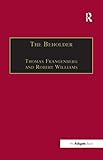Beholder The Experience of Art in Early Modern Europe
Language: English Publication details: Oxford Routledge 20161111Edition: 1Description: 244 pISBN:- 9781138257887
One of the most significant developments in the study of works of art over the past generation has been a shift in focus from the works themselves to the viewer's experience of them and the relation of that experience both to the works in question and to other aspects of cultural life. The ten essays written for this volume address the experience of art in early modern Europe and approach it from a variety of methodological perspectives: concerns range from the relation between its perceptual and significative dimensions to the ways in which its discursive formation anticipates but does not exactly correspond to later notions of 'aesthetic' experience. The modes of engagement vary from careful empirical studies that explore the complex complementary relationship between works of art and textual evidence of different kinds to ambitious efforts to mobilize the powerful interpretative tools of psychoanalysis and phenomenology. This diversity testifies to the vitality of current interest in the experience of beholding and the urgency of the challenge it poses to contemporary art-historical practice.
There are no comments on this title.
